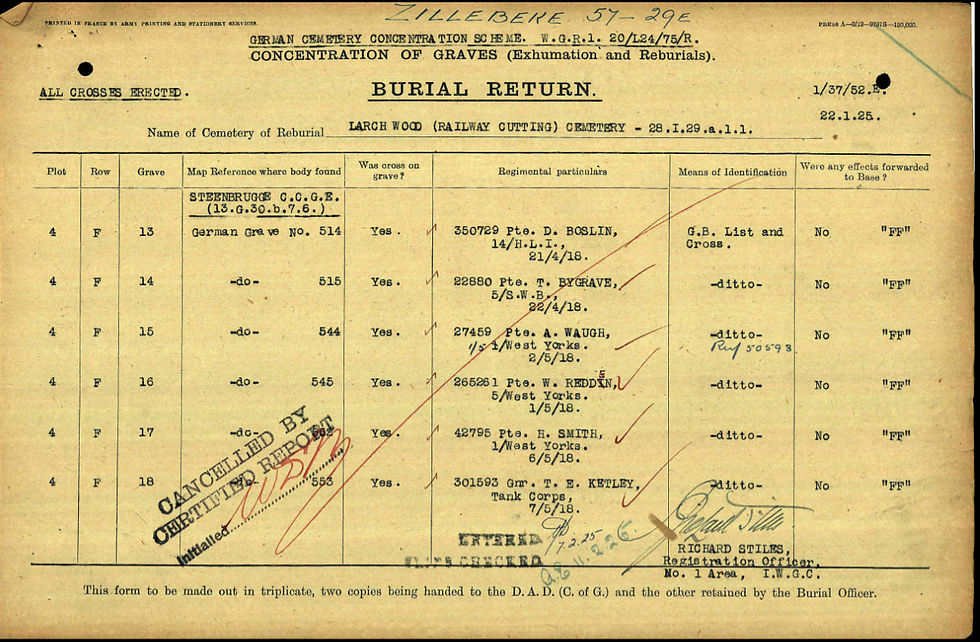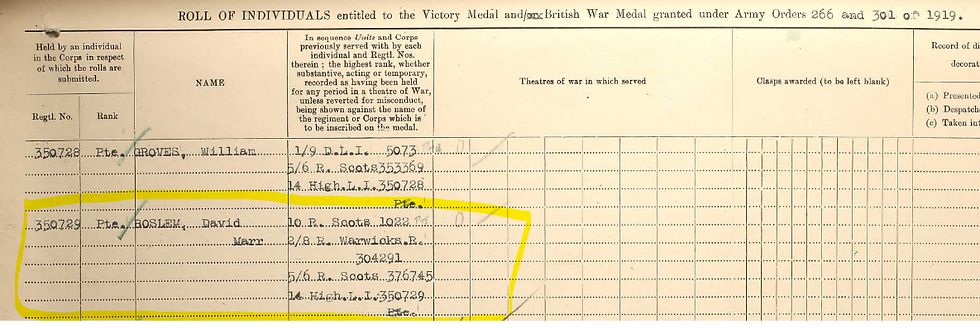
350729 Private
14th Battalion Highland Light Infantry, 120th Brigade, 40th Division
Age: 22
Date of Death: 21.4.18
Buried: Larch Wood (Railway Cutting) Cemetery IV.F.13
Family history: Son of Thomas and Jeanie Boslem, 11 Liston Terrace, Bridgeness. He had a brother John, who was serving with the 5/6th Royal Scots when he was killed in action on 16 July 1917. He is buried in the Coxyde Military Cemetery Grave I.J.41.
Prior to enlisting David was an apprentice blacksmith employed at Ballantine’s New Grange Foundry in Bo’ness. He enlisted on 4 August 1914 in the 1/10th Battalion Royal Scots, he was transferred to the 2/8th Royal Warwickshire Regiment and then to the 5/6th Royal Scots before finally being transferred to the 14th Battalion Highland Light Infantry.
The action leading to his death
Operation Georgette, to the Germans, or the Battle of the Lys to the British, opened on 9 April 1918. This was a large scale battle with a front line of some 37km’s that stretched from the La Bassee Canal almost to the gates of Ypres. Casualties on the British and commonwealth side totalled 82,000 dead, wounded, missing or taken prisoner. Georgette was carried out by the German 6th Army and part of the German Fourth Army and its main objective was to seize the rail head at Hazebrouck from where the British 2nd Army in Flanders was supplied. To the east, it would reach the Steenvoorde to Poperinge road which also supplied the 2nd Army in the Ypres Salient.
The 14th Battalion, Highland Light Infantry (HLI) were at Nouveau Monde, along with the 10th/11th Battalion HLI, they were essentially in reserve on the river line. At 4am Nouveau Monde came under artillery fire and the Battalion was ordered to Stand To. At 4.45am the Battalion moved forward to defensive line as per the Brigade standing defence scheme. The Battalion was in the line from Laventie East Post to Charred with one company in support. From 10am nothing more was heard of the three companies that had gone forward to occupy the front line. With the Germans now turning the British flank and following a discussion with the CO of the 2nd Royal Scots Fusiliers, who were on the Battalions left, it was decided to make a fighting retreat across the River Lys with the Battalion completing their crossing at 4pm. From 4.30pm to 10pm they held off the Germans on the other bank being relieved at 10pm by the 50th Division.

(Linesman Map. this is a modern map showing the area of the action of 9 April 1918)
David was wounded, a gunshot wound to the left arm, during the fighting and taken prisoner. He was taken to Limburg Prisoner of War Camp, located north-west of Frankfurt, before he was transferred to the German Naval Hospital in Bruges. He died there on 21 April 1918 from gas gangrene in the wound.
The Register of Soldiers Effects records his death at the Naval Hospital in Bruges.

His body was identified amongst the British dead buried at Bruges Town Cemetery.

On the 22 January 1925, his body was exhumed and reburied in Larch Wood (Railway Cutting) Cemetery.

Medals
The British War Medal, Victory Medal

Head Stone


Comments